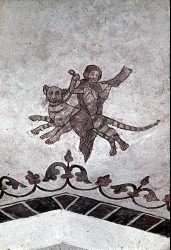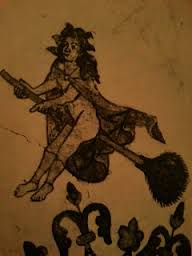The Earliest Broomstick Witch? May 27, 2016
Author: Beach Combing | in : Medieval , trackbackWitches fly in many different cultures: the British anthropologist Needham argued that it was a way of expressing their power, their ability to bring maleficum to all who get in their way or on their nerves. But in the European tradition witches have been associated, above all, with broomsticks: though note that witches were also to be seen jetting about the sky on cats (! Cross-contamination with valkyries?), on flails, on distaffs and on logs. There have been long and very suspect debates about where the broomstick came from. Was it just a female symbol (there is at least one judicial record of a man flying on a broomstick); was it an expression of comet (really!); was it an instrument to vaginally absorb hallucinogenic ointment that had been smeared onto the broom (another post another day). Rather than going down this particular wormhole Beach is going to restrict himself to a much simpler question today. When did the witch and broomstick emerge in western culture? Well, there are several fifteenth-century images in manuscripts: and if memory serves the first printed image dates to the late fifteenth century. However, the earliest image of a witch flying on a broomstick is usually said to date to c. 1300 and Germany (the cathedral of Schleswig in what used to be Denmark). Almost effortlessly c. 1300 has been backdated to the ‘twelfth century’ and in neo-pagan literature, where much is often made of this early witch, expect even bolder claims to antiquity. Note too the very suspect claim that this is Frigga in the neo-pagan image below.

The problem is that the dating simply does not hold up. For many years there was actually a minority opinion that this witch was a forgery (or re-elaboration) by a nineteenth-century restorer: perhaps an expression of how little she seems high medieval. This view has sunk practically out of sight now. However, in a very important essay in 2002 Wolfang Schild (‘Die zwei Schleswiger Hexlein. Einige Seufzer zu Lust und Last mit der Ikonologie’) went through the evidence for this mural witch (and another) at Schleswig and suggested 1450. A twelfth- or thirteenth-century date would be simply bizarre because there is not context for this kind of image. If this date is reliable and if we are not being misled by some kind of nineteenth century re-elaboration, then this may still be the earliest witch image but only just, as noted above there are manuscript broomstick witches from just that period. Above Beach asked why witches ride brooms and shrugged and walked off. The truth is that there is a much more critical question, why did witches start using brooms in the 1400s? There is simply no visual or written (or even photographic) evidence from before that date. Or is there… drbeachcombing AT yahoo DOT com
Note the second witch (?) in the cathedral, pictured below.

Bruce T, 31 Aug, 2016 ‘You owe me big, I’m still seeing spots on top of spots, damned pixilation! It’s a drawing of someone riding a six legged tiger, four front legs, two back, with reins. If it were a lion, I’d say Ethiopian/Byzantine and be done with it, the style is that close. The person riding the thing may or may not be a woman, they either have extremely saggy pointed breasts, or it’s a depiction of the solar plexus and rib cage flaring out under the open garment. The features are soft and youthful, possibly a woman, but possibly a male youth. The idea of low sagging breasts re; a young woman, doesn’t quite jibe. The hairstyle is typical of both women and men I’ve seen depicted from the era. The most interesting thing is the person is reading from a vellum page, likely delivering a message from on high. The idea of a misinterpretation of heavenly messenger is still my guess. There’s nothing that jumps out and says ‘Witch!’. Again my guess is someone unfamiliar with iconography depicted jumped to conclusions. Likely a novice monk not used to seeing flying tigers and that much skin. Now if you’ll excuse me I’m off to interpret Freya’s tattoos before my wife gets up. A woman like that could make a man want to go smite some English monks. No wonder the descendants of Vikings conquered Britain and Ireland twice with Goddesses like that. Where did I put my ax?



